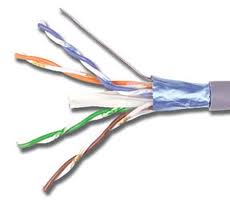We have different cables as option in wired medium .
The following sections discuss the types of cables used I networks and other related topics.
· Coaxial Cable
· Twisted pairs (Unshielded Twisted Pair (UTP) and Shielded Twisted pair (STP) Cables)
· Fiber Optic Cable
Coaxial Cable
Coaxial Cabling has a single copper conductor at its center .A plastic layer provides insulation between the center conductor ad a braided metal shield. The metal shield helps to block any outside interference from florescent lights ,motors ,and other computers .
Unshielded Twisted Pair (UTP) Cable
Unshielded Twisted Pair (UTP) is the most popular and is generally the best option for local networks
Categories of Unshielded Twisted Pair
Type | Use |
Category 1 | Voice Only (Telephone Wire) |
Category 2 | Data to 4 Mbps (Local Talk) |
Category 3 | Data to 10 Mbps (Ethernet) |
Category 4 | Data to 20 Mbps (16 Mbps Token Ring) |
Category 5 | Data to 100 Mbps(Fast Ethernet) |
Shielded Twisted Pair (STP) Cable
A disadvantage of UTP is that it ma6y be susceptible to radio and electrical frequency interference. Shielded twisted pair (STP) is suitable for environment with electrical interference; however, the extra shielding can make the cables quite bulky. Shielded twisted pair is often used on network using Token Ring.
Fiber Optic Cable
Fiber optic cabling consists of a center glass core surrounded by several layers of protective material. It transmits light rather than electronic signals eliminating the problem of electrical interference. This makes it ideal for certain environments that standard for connecting networks between buildings, due to its immunity to the effects of moisture and lighting.



No comments:
Post a Comment